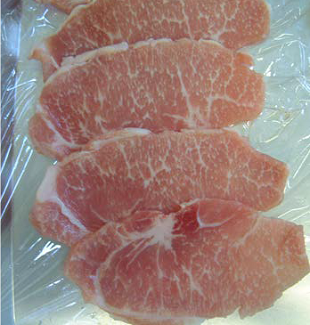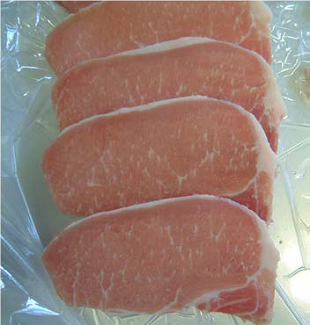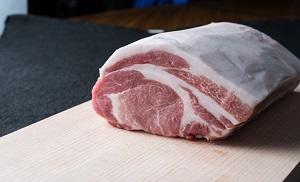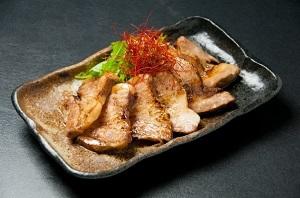Outcome Example of Bio-oriented Technology Research Advancement Institution
Issued on October 15, 2020



Marbled pork successfully developed
Most people would associate Japanese Black Beef, such as "Matsusaka beef" or "Tajima beef," as typical marbled meat. However, taking advantage of a technique enabling a change to amino acid composition contained in the feed, juicy and soft "marbled meat" was successfully created. This technique can increase the incomes of pig farmers and promote the export of Japanese pork under the brand name "High-Quality Marbled Pork."
With less lysine, fat is increased
Under the leadership of Dr. Shin'ichiro Takahashi, professor at Graduate School of Agricultural and Life Sciences, The University of Tokyo, and Dr. Masaya Katsumata, professor at School of Veterinary Medicine, Azabu University, a research group is engaged in R&D of the relationship between high-quality meat such as marbled pork and feed ingredients. A feed rich in protein composed of various amino acids is indispensable for animals to grow. The group reported that a large volume of fat might be accumulated in the muscle of pigs fed with less lysin, a type of amino acid.
Furthermore, a recent study by the research group has demonstrated that if the proportion of certain amino acids in the feed given to pigs is reduced, fat distribution changes such that more fat is accumulated in the muscles and the liver.
Dr. Takahashi et al. conducted a study in which feed with less lysine was given to growing pigs. Eleven pigs were divided into two groups, and low-lysin (0.4%) feed was given to the pigs in one group. Another group (control) was given the standard feed containing 0.65% lysine for two months to examine whether any difference in marbling rate would be made between the two groups. The result showed that the average fat content of 6.7% in pork loin was reported from pigs with low-lysin feed (Image 1), equivalent to two times that (3.5%) in pork loin from the pigs in the control group (Image 2). This difference is easily noticeable at first sight. The content-dependent relationship that the less the lysin concentration is, the higher the marbling level is, was revealed.
 |
 |
| Image 1: Pork loin from a pig with low-lysin feed given | Image 2: Pork loin from a pig with standard feed given |
Applicable to cross-bred pigs
Moreover, in another study, the Gifu Prefectural livestock research institute and the former National Institute of Agrobiological Sciences (current National Agriculture and Food Research Organization, NARO) jointly developed the pig species "Buono Brown" (Duroc pig) with a higher marbling level than standard pig by cross-breeding in 2009. The Italian word "buono" means "delicious." However, there was a challenging issue in the pigs generated by cross-breeding the Buono Brown species (three-way crossed Buono pork); namely, the marbling level was not so high as that of Buono Brown species.
The researchers specialized in both breeding and feed areas discussed their research to address this issue in cooperation with each other. Consequently, they decided to use the finding that the marbling level improves by adjusting the amino acid composition rate to the Buono Brown pork. They gave special feed with lysin content adjusted to pigs, resulting in the successful development of Buono pork with a higher rate of marbling (Image 3). The brand pork, which provides the consumers with the exquisite feeling of delicious taste and sweetness, made its debut.
Numerical evaluation of marbling level
|
At present, the "Chuno Meat Business Cooperative Association" (Seki, Gifu), which has participated in the demonstration experiment of the feed and meat quality, now handles all aspects of Buono pork, from slaughtering to sales. In the meat processing plants, the marbling rate is observed in the cut sections of every pig's pork loin part. Then, the meat is ranked on the 5-grade evaluation system. Only the pork loin ranked "2" or higher is shipped under the brand name "Buono Pork." It is quite rare throughout Japan that the marbling rate of pork is numerically ranked. Aiming at No. 1 brand pork in Japan, brand pork made their debut under the name of the place of production. This includes the "Mizunami Buono Pork" from "Katano Pig Farm" in MIzunami, the "Yamagata Buono Pork", and the "Ibigawa Buono Pork." Buono pork products occupy up to ~10% of total pork products produced and shipped in Gifu (as of October 2020). Buono pork products are mainly sold in butcher shops and small-sized supermarkets, and not in large-scale supermarkets. In Mizunami, a ham workshop has opened, and the consumers may enjoy a little luxury of pork dish at home (Image 4). |
 (Supplied by Chuno Meat Business Cooperative Association) |
 (Supplied by Chuno Meat Business Cooperative Association) |
Applicable to other species of livestock in the future
The technology of adjusting the amino acid content is applicable to the chicken and fish farming businesses. It is expected that giving low-protein feed to chicken will create the chicken liver with melt-in-the-mouth quality and giving to fish may raise high-grade brand-name fish with high-fat content. There is a plan to export overseas high-quality marbling brand pork from Gifu in the future.
Project name
The special scheme project on advanced research and development for next-generation technology
Project period
FY 2010 to 2014
Title
Establishment of technology for developing high-quality food resources using amino acid signals
Project research institute
Graduate School of Agricultural and Life Sciences, The University of Tokyo
